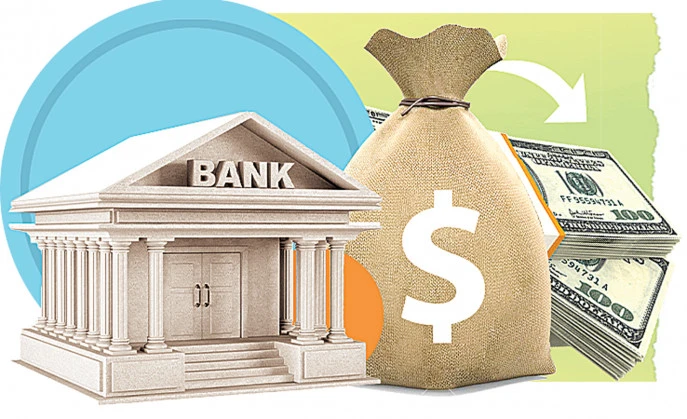The banking sector of Bangladesh has undergone significant changes over the years, and it continues to evolve. As a banker, it is essential to have a comprehensive and well-rounded perspective on the industry to navigate the complex and dynamic landscape successfully. This article aims to provide such a perspective by covering various aspects of the banking sector in Bangladesh, including its history, current state, challenges, opportunities, and future prospects.
Bangladesh is a developing country with a population of over 160 million people and a GDP of $446.35 billion. It is one of the fastest-growing economies in the world, with an average annual growth rate of 6.9% in the last decade.
But despite its impressive economic performance, Bangladesh still faces many challenges, such as poverty, inequality, corruption, environmental degradation, and political instability. These factors affect the business environment and the opportunities for entrepreneurs and investors.
One of the key sectors that can help overcome these challenges and unlock the potential of Bangladesh is the banking sector. The banking sector comprises 90% of the total financial sector assets in Bangladesh and has assets equivalent to 71% of GDP.
The banking sector plays a vital role in providing financial services, intermediating savings and investments, facilitating trade and commerce, and supporting economic development and social inclusion. However, the banking sector of Bangladesh also has many problems, such as low efficiency, high non-performing loans, weak governance, and inadequate regulation. These problems limit the growth and competitiveness of the banking sector and the economy as a whole.
History of Banking in Bangladesh
The history of banking in Bangladesh dates back to the early 19th century when the British established the first bank in the region. However, it was not until the 1950s that the banking sector started to take shape in its current form. The Bangladesh Bank, the central bank of the country, was established in 1971, and since then, the banking sector has grown significantly.
Key milestones in the development of the banking sector include the nationalization of banks in the 1970s and the liberalization of the industry in the 1980s. The introduction of private commercial banks in the 1990s and the expansion of Islamic banking in the 2000s have further transformed the industry.
The Current State of the Banking Sector of Bangladesh
The banking sector of Bangladesh consists of four categories of scheduled banks: state-owned commercial banks (SCBs), government-owned development finance institutions (DFIs), private commercial banks (PCBs), and foreign commercial banks (FCBs). As of 2023, there are 62 banking institutions operating in the country, including 44 domestic PCBs.
The SCBs and DFIs account for 25% of the total banking assets, but they are still inefficient and loss-making. They suffer from poor management, political interference, corruption, and high non-performing loans (NPLs). The NPL ratio of SCBs and DFIs was 24.9% and 54.8%, respectively, as of June 2023.
The PCBs and FCBs account for 75% of the total banking assets, and they are more profitable and competitive. They offer a wide range of products and services, such as retail banking, corporate banking, SME banking, Islamic banking, online banking, mobile banking, and so on. They also use modern technology and innovation to enhance their efficiency and customer satisfaction. The NPL ratio of PCBs and FCBs was 4.1% and 2.5%, respectively, as of June 2023.
The banking sector of Bangladesh has shown remarkable resilience and growth in the face of the COVID-19 pandemic and the global economic crisis. The total assets of the banking sector increased by 13.6% year-on-year to reach $321 billion as of June 2023. The total deposits and loans of the banking sector increased by 14.3% and 11.6%, respectively, to reach $253 billion and $226 billion as of June 2023. The banking sector also maintained a healthy capital adequacy ratio of 12.1% and a liquidity coverage ratio of 148.2% as of June 2023.
However, the banking sector of Bangladesh also faces many risks and challenges, such as:
- Low credit growth: The credit growth of the banking sector slowed down to 10.5% in June 2023, compared to 12.7% in June 2022, due to the lower demand and supply of credit amid the pandemic and the international uncertainty. The credit growth of the private sector was even lower at 10.2%, compared to 13.4% in June 2022.
- High interest rate spread: The interest rate spread of the banking sector, which is the difference between the average lending rate and the average deposit rate, was 3.8% in June 2023, which is still one of the highest in the world. The high interest rate spread indicates the inefficiency and lack of competition in the banking sector, and it discourages savings and investments.
- Weak governance and regulation: The banking sector of Bangladesh suffers from weak governance and regulation, which undermine its transparency, accountability, and stability. The banking sector is prone to political influence, corruption, fraud, and money laundering. The regulatory framework is also outdated, inconsistent, and ineffective. The Bangladesh Bank, which is the central bank and the regulator of the banking sector, has limited autonomy and capacity to supervise and enforce the banking laws and regulations1.
Challenges Facing the Banking Sector of Bangladesh
The banking sector in Bangladesh faces several challenges, including nonperforming loans (NPLs), lack of skilled workforce, regulatory challenges, and cybersecurity threats. The NPL ratio of banks in Bangladesh is relatively high, and the lack of skilled workforce hampers the growth of the industry. Regulatory challenges, such as the capital adequacy ratio (CAR) requirements, pose a significant challenge for banks in Bangladesh. Cybersecurity threats are also a growing concern for the industry.
Opportunities in the Banking Sector of Bangladesh
Despite the challenges, there are several opportunities in the banking sector in Bangladesh. The growing middle class presents a significant opportunity for banks to expand their customer base. The increasing use of technology, such as mobile banking and online banking, provides banks with new channels to reach customers. The expansion of Islamic banking presents another opportunity for banks to diversify their product offerings. The government’s initiatives to promote financial inclusion, such as providing access to clean water and achieving food security, also provide opportunities for banks to expand their reach.
Future Prospects of the Banking Sector of Bangladesh

Despite the challenges, the banking sector of Bangladesh has a bright future, as it has many opportunities and potentials to grow and improve. Some of the factors that will drive the growth and development of the banking sector :
Economic recovery and growth
The economy of Bangladesh is expected to recover and grow in the post-pandemic period, as the government and the Bangladesh Bank have taken various fiscal and monetary measures to support the affected sectors and stimulate the demand and supply of credit. The GDP growth of Bangladesh is projected to rebound to 5.1% in 2021 and 6.8% in 2022, according to the World Bank. The economic growth will increase the demand and supply of banking services, such as trade finance, project finance, working capital finance, consumer finance, and so on.
Financial inclusion and literacy
The banking sector of Bangladesh has a huge potential to expand its outreach and penetration, as a large segment of the population and the economy remains unbanked or underbanked. According to the World Bank, only 50% of the adult population in Bangladesh had an account at a financial institution in 2017, compared to the global average of 69%. The banking sector can leverage the digital technology and innovation, such as mobile banking, agent banking, internet banking, and so on, to reach the unbanked and underbanked customers, especially in the rural and remote areas. The banking sector can also enhance the financial literacy and awareness of the customers, by providing them with financial education and counseling, and by offering them customized and affordable products and services.
Diversification and innovation
The banking sector has a lot of scope to diversify and innovate its products and services, to cater to the changing and diverse needs and preferences of the customers. The banking sector can offer more value-added and differentiated products and services, such as green banking, Islamic banking, SME banking, women banking, and so on, to tap into the niche and untapped markets. The banking sector can also use the artificial intelligence, big data, blockchain, cloud computing, and so on, to enhance its efficiency, security, and customer experience.
Frequently asked questions (FAQs)
What is the role of the Bangladesh Bank in regulating and supervising the banking sector?
The Bangladesh Bank is the central bank of the country and the apex regulatory body for the banking sector. It is responsible for formulating and implementing monetary policy, maintaining price stability, ensuring financial stability, managing foreign exchange reserves, issuing currency notes, and overseeing the payment system. It also supervises and regulates the banking sector through various prudential norms, guidelines, and directives. The Bangladesh Bank has the authority to grant licenses, conduct inspections, impose penalties, and take corrective actions against the banks.
What are the main types of banks operating in the banking sector of Bangladesh?
The banking sector of Bangladesh consists of four categories of scheduled banks: state-owned commercial banks (SCBs), government-owned development finance institutions (DFIs), private commercial banks (PCBs), and foreign commercial banks (FCBs). As of 2023, there are 62 banking institutions operating in the country, including 44 domestic PCBs. The SCBs and DFIs account for 25% of the total banking assets, while the PCBs and FCBs account for 75%. The PCBs and FCBs are more profitable and competitive than the SCBs and DFIs, which suffer from low efficiency, high non-performing loans, weak governance, and inadequate regulation.
What are the main challenges facing the banking sector of Bangladesh?
The banking sector of Bangladesh faces many challenges, such as low financial inclusion, high interest rate spread, high non-performing loans, weak governance, corruption, political interference, cyber security risks, and environmental and social risks. These challenges limit the growth and competitiveness of the banking sector and the economy as a whole. The banking sector of Bangladesh also needs to cope with the impact of the COVID-19 pandemic and the global economic crisis, which have affected the demand and supply of credit, the liquidity and solvency of banks, and the quality of assets and capital.
What are the main opportunities for the banking sector of Bangladesh?
The banking sector of Bangladesh has many opportunities, such as increasing financial inclusion, expanding digital banking, diversifying products and services, tapping into new markets and segments, enhancing customer satisfaction, improving efficiency and innovation, strengthening governance and compliance, and contributing to sustainable development. These opportunities can help the banking sector of Bangladesh to increase its profitability and market share, improve its resilience and performance, and support the economic and social development of the country.
What are the future prospects of the banking sector of Bangladesh?
The future prospects of the banking sector of Bangladesh depend on various factors, such as the macroeconomic situation, the regulatory environment, the competitive landscape, the technological advancement, and the customer behavior. The banking sector of Bangladesh is expected to grow at a moderate pace in the next few years, driven by the recovery of the economy, the expansion of credit, the adoption of digital banking, and the improvement of governance and regulation. However, the banking sector of Bangladesh also faces many uncertainties and risks, such as the evolution of the COVID-19 pandemic and its variants, the volatility of the global financial markets, the emergence of new competitors and disruptors, and the changing expectations and preferences of customers. Therefore, the banking sector of Bangladesh needs to be agile, adaptive, and proactive to seize the opportunities and overcome the challenges in the dynamic and complex environment.
Conclusion
In conclusion, the banking sector of Bangladesh has come a long way since its inception. The industry has undergone significant changes, and it continues to evolve. While there are challenges facing the industry, there are also several opportunities for growth and expansion. As a banker, it is essential to have a comprehensive and well-rounded perspective on the industry to navigate the complex and dynamic landscape successfully.
